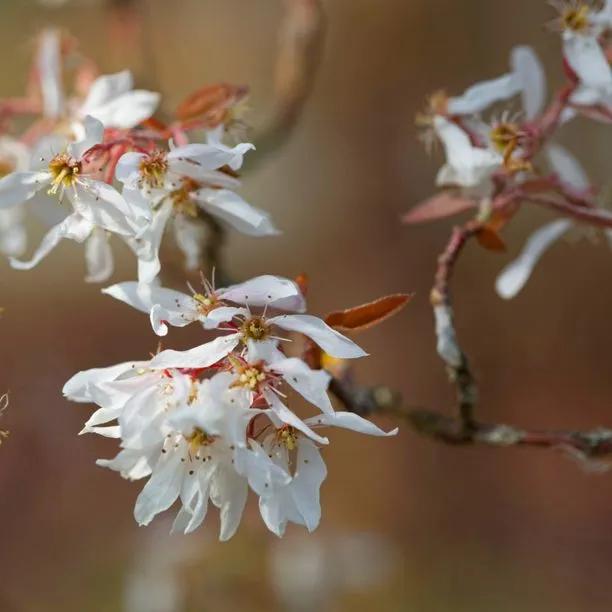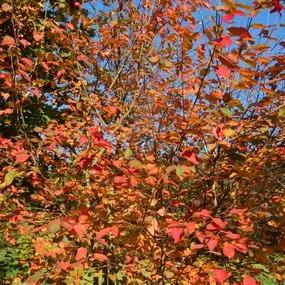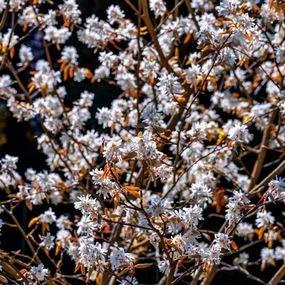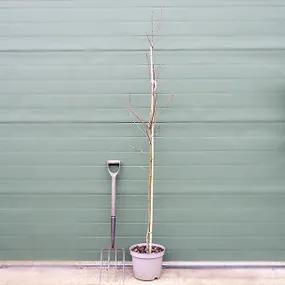Amelanchier Robin Hill, Large Trees
The details
- Small, upright & bushy.
- Profuse pink & white spring flowers.
- Fiery autumn colour.
- Edible fruit.
- Good for shallow, rocky soils except chalk
- Max. Height 10 metres.
- Bareroot Delivery: Nov-Mar
- RHS Award of Garden Merit
Description
Amelanchier Robin Hill, Standard Size Trees
Amelanchier Robin Hill is small, fairly upright and graceful, with year round ornamental interest. The pink buds and young flowers open in April when the leaves are barely breaking, completely filling the tree with a cloud of flowers. The petals turn from pink to white as they mature. The young leaves are flushed with a bronze tone that fades to a rich green by summer. By August, the flowers ripen into a modest quantity of edible, deep red berries, about a centimetre across (all Amelanchiers are self-fertile, so you only need one tree). They look and taste a little like blueberries, are a good source of iron and can be dried, but you have to get them before the birds do. The fiery Autumn display is superb, and in winter, the slender branches look lovely against a cold steel sky.
Grown with a straight trunk, it can reach about 9 metres.
Browse all of our ornamental & garden trees, or our other trees for small gardens.
Features:
- Pink buds open to profuse pink flowers in April, maturing to white
- Edible berries in August
- Splendid red & yellow Autumn colour
- Looks elegant in winter
- To 9 metres
- Prefers neutral to mildly acidic, well drained soil
- RHS Award of Garden Merit
Growing Amelanchier Robin Hill
An undemanding tree that only needs decent drainage and a neutral to mildly acidic soil pH. The spreading, shallow fibrous roots are great for holding loose soil in place on a mound or bank, or thin topsoils on rocky locations. It is hardy, wind resistant, and suitable for coastal gardens. It benefits from a mulch in late spring / early summer.
It has a suckering habit that will tend to turn it into a large shrub over time if they are not removed.
Planting Instructions
Planting Your Amelanchier Robin Hill Tree and Aftercare
It needs a lime free soil that is moist but still quite well drained; heavy clay is usually fine, as long as it doesn't get very waterlogged in winter. A sunny site is best as this will ensure a thick head of flowers, but it will still grow well in partial shade. They are hardy trees that don't mind a hard frost.
Prepare your site before planting
It is good to prepare the site where you plant a tree several months in advance by digging over. Kill the weeds first: for tough weeds like nettles, brambles and ground elder, you will usually need a weed-killer to get rid of them. When you dig the soil over, remove stones and other rubbish and mix in well rotted compost or manure down to the depth of about 2 spades.
Pro Tips
- Watch our video on how to plant a tree for full instructions.
- Remember to water establishing trees during dry weather for at least a year after planting.
Aftercare
Remember to check the stake and tie supporting your trees a few times a year. Tighten the tie if it becomes loose and loosen it as the tree grows. Make sure that the tree's trunk isn't rubbing against the stake. This shallow rooted tree will perform best when it receives a yearly mulch of well-rotted manure or compost to help keep the soil around it fertile. Remove suckers from the base, unless you want it to become shrubby.
Did You Know?
It was bred at the Robin Hill Arboretum & Nature Preserve in New York State during the 1960's from Amelanchier arborea and A. laevis, and was previously classified as the former.
Standard trees are measured by their girth in centimetres 1 metre above ground level: their trunk's waist measurement. Unlike sapling trees and hedge plants, standards aren't measured by their height, which will vary quite a bit both between and within species.
So, a 6/8cm standard tree has a trunk with a circumference of 6-8cm and an 8/10 standard has a trunk 8-10cm around. This measurement makes no difference to the tree's final height.
On average, standard trees are 2-3.5 metres tall when they arrive, but we cannot tell you precisely how tall your trees will be before we deliver them.





